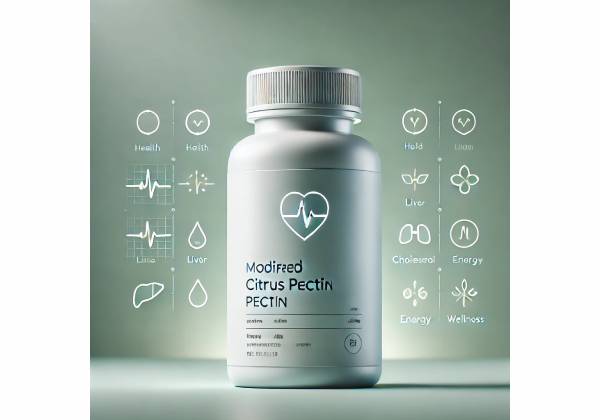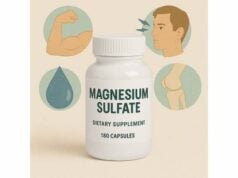
Modified citrus pectin (MCP) is a uniquely processed fiber derived from citrus peel. Unlike ordinary pectin used for jam-making, MCP is broken down to smaller, more absorbable fragments with a low degree of esterification. That structural change lets MCP circulate in the body and bind to targets such as galectin-3—a carbohydrate-binding protein linked with fibrosis, inflammation, and cancer biology. Interest in MCP typically centers on three areas: support during cancer care, cardiovascular and fibrotic health, and “gentle” heavy-metal detoxification. Early human studies suggest MCP can influence biomarkers (for example, PSA kinetics in biochemically relapsed prostate cancer) and increase urinary excretion of certain metals under monitored conditions. At the same time, evidence is mixed and still evolving. Most people tolerate MCP well, but it is still a biologically active supplement that can interact with health conditions and medications. This guide translates the research into practical, people-first advice—what MCP is, how it might work, how it is used in studies, and the safety essentials you should know before considering it.
Quick Overview
- May modulate galectin-3 activity relevant to fibrosis and cancer biology.
- Short courses can increase urinary excretion of arsenic, cadmium, and lead in monitored settings.
- Study doses range from 14–20 g/day in divided doses, depending on protocol and objective.
- Common effects include mild digestive upset; avoid if allergic to citrus or on restricted-fiber regimens.
- Not appropriate without medical guidance for pregnancy, severe kidney disease, or in children outside supervised care.
Table of Contents
- What is modified citrus pectin?
- Does it work and for what?
- Benefits and how it works
- How to choose and use it
- How much should you take?
- Side effects and who should avoid it
What is modified citrus pectin?
Modified citrus pectin (MCP) starts as ordinary citrus pectin—the soluble fiber found in orange, lemon, and grapefruit peels. Food-grade pectin has large, branched chains that mostly pass through the gut. MCP is different: manufacturers break the long chains into smaller fragments and reduce their degree of esterification (DE). These changes increase solubility and allow some MCP fragments to be absorbed from the small intestine into the bloodstream. Researchers are most interested in galacturonic-acid-rich regions and rhamnogalacturonan-II (RG-II) motifs; both contribute to MCP’s biological behavior.
Chemically, MCP is usually described by two numbers: average molecular weight and DE. In a widely cited pilot study exploring heavy metal excretion in adults, the MCP used had a weight-average molar mass around 15.4 kDa and a DE of ~3.8%. Those values offer a reference point for “low-molecular-weight, low-DE” MCP that can circulate and interact with biological targets. By contrast, standard pectin found in foods often falls in the 80–400 kDa range with higher esterification and is not expected to be appreciably absorbed.
Why does this matter? The structural details determine what MCP can bind to. One of the most studied targets is galectin-3, a lectin that recognizes β-galactoside–containing glycans on cell surfaces and in the extracellular matrix. Galectin-3 helps cells stick together, migrate, and remodel tissue—processes that are essential in wound healing but problematic when chronically activated, such as in fibrosis or metastatic spread. MCP’s galactose-rich chains appear able to occupy galectin-3’s carbohydrate recognition domain, acting as a competitive antagonist. That “glycan decoy” behavior is the central rationale for many proposed MCP uses.
Beyond galectin-3, certain pectin fragments—including RG-II—can chelate metals through carboxyl and hydroxyl groups, forming complexes that may be excreted in urine or stool. This is why MCP shows up in discussions of “gentle detox” after environmental exposures. It is important to separate marketing from measured effects, though: the best data come from monitored protocols with quantified pre- and post-excretion and medical oversight.
In the marketplace, MCP typically appears as an unflavored powder to mix with water or juice; capsules are also available. Formulas may blend MCP with alginates (seaweed-derived polysaccharides) when the goal is to reduce gastrointestinal reabsorption of metals. Labels sometimes list average molecular weight or DE, but not all products disclose these metrics. When in doubt, look for transparent specifications and clinical-grade manufacturing practices.
Finally, expectations should be grounded. MCP is not a cure or substitute for standard care. It is best thought of as an adjunct under professional guidance, especially where the intent is to influence biomarkers or manage toxicant exposure. Throughout this guide you’ll see study-based examples to keep usage anchored to measured outcomes.
Does it work and for what?
The honest answer is: MCP shows promise in specific, narrow contexts, but evidence quality varies, and results are not uniform across outcomes.
Cardiovascular and fibrosis. A randomized, placebo-controlled trial in adults with hypertension and elevated galectin-3 tested whether MCP would change circulating markers of collagen metabolism. It did not meaningfully shift those fibrosis-related markers over the treatment window. That result tempers the idea that galectin-3 antagonism automatically translates into rapid biomarker change in cardiovascular disease. Still, the trial confirms feasibility and safety in this population and underscores the need for better endpoints, longer follow-up, or different patient selection (for example, overt heart failure or high-fibrosis phenotypes) when testing MCP’s antifibrotic potential.
Oncology. MCP is frequently discussed as a supportive agent in cancer care because galectin-3 participates in tumor cell aggregation, adhesion, immune evasion, and metastasis. In a prospective, multicenter phase II study of men with non-metastatic biochemically relapsed prostate cancer (rising PSA after definitive local therapy), patients received 4.8 g of MCP three times daily. After six months, most participants had either stabilized/decreased PSA or an improved PSA doubling time (PSADT), and adverse effects were minimal. While that’s encouraging, it’s important to recognize the limitations: the study was single-arm and cannot exclude natural PSADT variability or selection effects. Randomized evidence is still needed to determine who benefits, optimal duration, and whether such biomarker improvements translate into harder clinical endpoints (metastasis-free survival, time to systemic therapy).
Detoxification and toxicant exposure. Several small human investigations—ranging from case series to monitored, time-limited protocols—suggest MCP can increase urinary excretion of metals such as arsenic, cadmium, and lead. In adults with typical background exposures, a short course produced large percentage increases in urinary excretion (for example, cadmium and lead) over baseline collection periods. In hospitalized children with clinically significant lead levels, a month of MCP (under medical supervision) lowered blood lead and increased urinary elimination without serious adverse effects. These studies are preliminary, but they show a consistent direction of effect in controlled settings. The key caveats: chelation of any form should not be DIY; it requires clinician oversight, pre- and post-testing, and attention to mineral status and kidney function.
Neurologic and other areas. Preclinical work indicates MCP’s galectin-3 antagonism may dampen microglial activation, NLRP3 inflammasome signaling, and matrix metalloproteinase activity in ischemic and hemorrhagic brain injury models. Translational data in humans are not yet available. Likewise, early-stage studies in osteoarthritis and other inflammatory conditions show mixed results and, so far, have not provided robust, consistent clinical benefits over placebo.
Taken together, MCP is best framed as: (1) a galectin-3–targeting adjunct with a plausible role in specific oncology scenarios where biomarkers guide decisions; (2) a monitored, time-limited option for toxicant management under medical care; and (3) an investigational tool in cardiovascular and fibrotic disease with feasibility supported but outcomes uncertain. If any of these use-cases resonate, speak with a clinician who understands both conventional care and integrative protocols so the choice to use MCP adds value, not noise, to your plan.
Benefits and how it works
Three mechanistic pillars explain most of MCP’s proposed benefits: galectin-3 antagonism, metal-binding/chelation, and the physiologic effects of soluble fiber.
Galectin-3 antagonism. Galectin-3 is a lectin that binds β-galactosides on cell-surface and extracellular-matrix glycoconjugates. Its role in tissue remodeling is double-edged. In wound healing, galectin-3 supports repair; chronically, it helps drive fibroblast activation, collagen deposition, and organ fibrosis. In cancer biology, galectin-3 can facilitate tumor cell aggregation in circulation, adhesion at new sites, angiogenesis, and immune escape. MCP’s galactose-rich regions and RG-II side chains provide multiple binding sites that can occupy galectin-3’s carbohydrate recognition domain. In vitro and animal models, this looks like a decoy effect that blunts galectin-3–mediated cell-cell and cell-matrix interactions. Clinically, antagonism may manifest as changes in kinetic markers (for example, PSA doubling time) or, in theory, slower fibrotic remodeling. However, because galectin-3 sits within complex networks, single-agent antagonism does not guarantee macroscopic clinical changes in every context.
Metal-binding and elimination. Carboxyl and hydroxyl groups on pectin chains can bind divalent and trivalent metals. RG-II domains, in particular, appear adept at chelating various cations. In monitored human protocols, short-term MCP increased urinary excretion of arsenic and cadmium, and in pediatric lead toxicity it reduced blood lead while boosting urinary elimination. This suggests MCP can act as a mild, non-infusional chelator. The effect is subtler than intravenous agents; it often requires repeated dosing, adequate hydration, and close monitoring of mineral status to avoid unintended depletion. In some formulations, MCP is paired with alginate to reduce enterohepatic recirculation and favor fecal binding of metals, a strategy aimed at diminishing reabsorption.
Fiber-related benefits. MCP remains soluble fiber and can influence stool consistency, satiety, and post-prandial glycemia. While not the primary rationale for MCP, these attributes may be welcome side benefits. Gut comfort varies by person: some report improved regularity; others experience transient bloating or loose stool when dosing escalates too quickly.
What MCP does not do: It is not a stand-alone cancer treatment, cure for heart failure, or universal detox remedy. Effects, when present, are usually biomarker-level or incremental. That doesn’t make MCP trivial—incremental changes matter in long courses of chronic disease—but it does mean that realistic goals and proper integration with standard care are essential.
Who might benefit? Based on today’s data, reasonable scenarios include: individuals in a watchful-waiting or non-urgent phase of certain cancers under oncology supervision; adults with documented environmental exposures requiring a gentle, outpatient chelation approach; and patients within clinical trials that test antifibrotic strategies grounded in galectin-3 biology. In each case, MCP is a “maybe helpful” adjunct, not a replacement for proven therapies.
How to choose and use it
Prioritize transparency and study-informed specifications. Because MCP is defined by structure, not brand, focus on products that disclose average molecular weight and degree of esterification (DE). Human studies have used low-molecular-weight MCP with low DE; one pilot chelation study reported ~15.4 kDa and ~3.8% DE. Not all commercial labels list these numbers, but requesting a certificate of analysis can help you verify that what you’re buying matches the intended use.
Pick a format you can take consistently. Powder lets you build dose flexibly and is easier for higher daily amounts used in research protocols; capsules are convenient for maintenance-style use but can be impractical at higher gram totals. If your goal involves toxicant management, ask whether the product contains MCP alone or MCP with alginate; both strategies appear in the literature, each with its rationale.
Build a plan with your clinician. Even when using off-the-shelf supplements, treat MCP like a medication: agree on a goal, choose start and target doses, define the trial period, and pick the outcomes you’ll monitor. Examples include pre- and post-24-hour urinary metals under standardized conditions, kinetics such as PSA doubling time in prostate cancer surveillance, or symptom-linked measures like bowel regularity and overall tolerability.
Layer in practical tactics:
- Hydrate well. Aim for regular fluid intake, especially on higher-dose days or when the goal is enhanced urinary elimination.
- Separate from medications and minerals. As a binding fiber, MCP may reduce absorption of oral drugs and micronutrients. A common practice is to separate MCP from medications and mineral supplements by at least 2–4 hours.
- Escalate gradually. If you’re new to MCP, start low and titrate over 1–2 weeks to minimize digestive side effects.
- Time courses matter. Study protocols often use sustained daily dosing for months (oncology biomarkers) or short, intensive courses (5–6 days) for monitored detox testing.
- Track what matters. Don’t rely on vague impressions. For detox goals, use laboratory testing with the same lab and collection method each time. For oncology goals, ensure your oncology team agrees with the biomarker plan and follow-up interval.
Finally, avoid overpromising blends. MCP sometimes appears in multi-ingredient formulas with impressive claims. More ingredients don’t guarantee better results and may increase the risk of interactions or side effects. When evidence is nascent, simplicity and measurability are your friends.
How much should you take?
There is no one universal “MCP dose.” Instead, use the doses from published protocols as anchors and adjust with your clinician. Below are study-grounded examples and practical considerations.
Study-based anchors
- Prostate cancer biomarker management (biochemically relapsed, non-metastatic): 4.8 g three times daily (total 14.4 g/day) for six months, with extension for responders. This approach aimed to stabilize PSA or improve PSA doubling time while monitoring for progression and toxicity.
- Adult monitored detoxification (background exposures): 15 g/day for five days followed by 20 g on day six, with 24-hour urine collections to quantify changes in excretion of arsenic, cadmium, and lead.
- Pediatric lead toxicity (hospitalized, supervised): 15 g/day divided into three doses over 28 days, with serial blood and urine monitoring. Pediatric use should be strictly medical-supervised; do not extrapolate to home use.
Practical frameworks
- “Introductory” titration: For adults testing tolerability before building toward a study-level target, a conservative approach is to start with ~2–3 g once daily for several days, then increase to 2–3 g twice daily. If well tolerated and aligned with your goal, stepwise increases can continue toward the chosen protocol.
- “Biomarker-focused” plan: If your objective is to influence a kinetic marker (for example, PSADT), align the daily total with the oncology protocol above, confirm your care team is on board, and pre-define the evaluation window (often 3–6 months).
- “Short, monitored detox” plan: Only with clinician oversight, use a time-limited course similar to adult protocols, paired with hydration, mineral repletion as needed, and pre/post 24-hour urinary metals using the same lab.
Timing and administration
- Take MCP with a full glass of water. Powder mixes best in room-temperature water or diluted juice.
- If you experience bloating or loose stools, reduce the dose, split it into more frequent smaller servings, or slow your titration.
- Separate doses from medications and mineral supplements by 2–4 hours to reduce the chance of binding and reduced absorption.
Special notes
- Food vs. empty stomach: Both patterns appear in practice. If GI comfort is an issue, taking MCP with light food may help.
- Cycling: Some people use cycles (for example, five days on, two off) during longer courses to balance adherence and GI comfort. There is no established best cycle; choose one you can stick with and monitor your outcomes.
Remember: the dose that matters is the one linked to a clear goal and measured outcome, taken consistently, and monitored for benefit and tolerance. Anything else is guesswork.
Side effects and who should avoid it
MCP is generally well tolerated, but “generally” is not “universally.” Know the predictable issues and the red-flag scenarios before you start.
Common, usually mild effects
- Digestive changes. Gas, bloating, or loose stools are the most frequent complaints, especially when doses are escalated quickly. Slowing the titration, splitting doses, and taking MCP with water or light food often resolves these issues.
- Taste/texture. The powder is bland to slightly citrusy; texture can be noticeable in water. Mixing into diluted juice or smoothies improves palatability.
Less common considerations
- Mineral balance. Any chelating approach, even gentle, can alter mineral status. In monitored detox protocols, clinicians often assess iron, zinc, magnesium, and other micronutrients and may recommend repletion strategies.
- Medication timing. As a binding fiber, MCP can reduce absorption of oral medications and minerals. Separate by at least 2–4 hours unless your prescriber instructs otherwise.
- Allergies. People with known citrus allergies or sensitivity should avoid MCP. Discontinue and seek care for rash, swelling, wheezing, or other hypersensitivity signs.
Who should not use MCP without medical guidance
- Pregnancy and breastfeeding. Safety data are lacking. Avoid unless your obstetric provider explicitly recommends and monitors it.
- Children and adolescents. Pediatric use belongs in supervised medical care for defined indications (for example, documented lead toxicity). Do not use at home based on adult protocols.
- Significant kidney disease or kidney stones. Chelation alters renal handling of metals and minerals; medical oversight and individualized risk/benefit are essential.
- Major GI disease or recent GI surgery. Added soluble fiber may aggravate symptoms or complicate nutrition plans; ask your gastroenterology team.
- Active cancer treatment. MCP can be used in integrative oncology, but coordination with your oncology team is mandatory to avoid interference with therapy timing or clinical trials.
Warning signs that need evaluation
- Persistent GI distress, severe constipation or diarrhea, or unintended weight loss.
- New swelling, rash, or breathing difficulty.
- Worsening fatigue, muscle cramps, or heart rhythm symptoms (which could, rarely, reflect mineral shifts).
- Any unexpected change in your monitored biomarker that deviates from the plan.
Expectations and endpoints
- Cancer care: Look for agreed-upon changes in kinetic markers such as PSA doubling time at pre-specified intervals. MCP should not delay indicated systemic therapy or definitive intervention.
- Detoxification: Seek objective evidence (pre-/post-testing). Symptom-only “detox” claims without data are not a reliable way to judge benefit.
Bottom line: MCP can be a reasonable adjunct for targeted goals when chosen thoughtfully, introduced gradually, and monitored carefully. If your situation falls into a higher-risk category, involve your care team before the first dose.
References
- Galectin-3 Inhibition With Modified Citrus Pectin in Hypertension 2021 (RCT)
- Modified Citrus Pectin Treatment in Non-Metastatic Biochemically Relapsed Prostate Cancer: Results of a Prospective Phase II Study 2021 (Phase II)
- The effect of modified citrus pectin on urinary excretion of toxic elements 2006
- The role of modified citrus pectin as an effective chelator of lead in children hospitalized with toxic lead levels 2008
- Pleiotropic Effects of Modified Citrus Pectin 2019 (Review)
Disclaimer
The information in this article is educational and is not a substitute for personalized medical advice, diagnosis, or treatment. Do not start, stop, or change any medication or supplement without talking to your qualified healthcare professional. If you are pregnant, breastfeeding, have kidney disease, a gastrointestinal disorder, cancer, or are considering MCP for detoxification, consult your clinician for individualized guidance and monitoring.
If you found this guide useful, please consider sharing it on Facebook, X (formerly Twitter), or your preferred platform, and follow us for future updates. Your support helps us continue creating clear, trustworthy health content.










